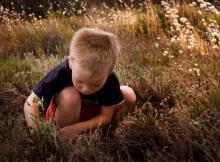
Biophilia is a term invented by psychologist Erich Fromm to describe the love of life and living systems. Edward O. Wilson, a Pulitzer Prize winning author and Harvard biologist, expanded on the meaning and emphasis of biophilia believing that the human love of nature and animals is a genetic result of evolutionary processes. The love of nature, suggested to be genetically encoded in humans, was further investigated in The Biophilia Hypothesis, edited by Wilson and Stephen Kellert.1
People are drawn to natural settings, such as gardens and forests, and nature play offers many benefits for children and adults alike. More than a century ago, American naturalist John Muir noted, “Thousands of tired, nerve-shaken, over-civilized people are beginning to find out that going to the mountains is going home; that wilderness is a necessity; and that mountain parks and reservations are useful not only as fountains of timber and irrigating rivers, but as fountains of life.”2
Environmental psychologists suggest that biophilic tendencies in people are evident when they experience real benefits from natural settings. Research has shown that hospital environments that include plants and natural settings are therapeutic and aid recovery times, and benefits are also seen in the work place as well as school rooms when natural elements are added. Urban design that brings nature into the plans with trees, parks, greenways, and wilderness areas promotes calmer, healthier environments for the residents.3
Children express their natural love of nature at an early age. They are drawn to animals, especially baby animals, and naturally develop empathy for them and a sense of wonder. Elementary-aged school children enjoy opportunities to explore in natural environments as they follow streams, hunt for treasures, and imagine play adventures. These natural environments have four qualities that are especially appealing to children: their unending diversity, the fact that adults do not create them, their feeling of timelessness in settings that could have been in fairy tales, and the fact that they are the home of animals.4
Natural environments offer open-ended play for children with natural elements that can be manipulated, such as dirt, sand, water, and plants. Natural elements stimulate discovery and wonder and encourage imagination and pretend play. Children tend to play longer in outdoor settings and are more physically active. They enjoy greater independence in outdoor spaces, are freer to run and shout, and can enjoy messier activities than when playing indoors.5
If children are not given opportunities to develop their natural attraction to nature, they could develop biophobia, an aversion to nature. Children with biophobic tendencies might feel discomfort in natural settings and be fearful of dirt, germs, and bugs not found in sterile, man-made environments. The concern of environmental psychologists is that these children could grow up to view nature as nothing more than a disposable resource with little regard for the environment.6
- 1. Ellis-Christensen. “What is Biophilia?” WiseGeek. < http://www.wisegeek.com/what-is-biophilia.htm > 29 Sep. 2011.
- 2. Louv, Richard. “The Powerful Link Between Conserving Land and Preserving Human Health.” Children & Nature Network. < http://www.childrenandnature.org/blog/2007/07/01/the-powerful-link-between-conserving-land-and-preserving-health/ > 21 Sep. 2011.
- 3. Ibid.
- 4. White, Randy. “Moving from Biophobia to Biophilia: Developmentally Appropriate Environmental Education for Children.” White Hutchinson Leisure & Learning Group. < http://www.whitehutchinson.com/children/articles/biophilia.shtml > 10 June 2011.
- 5. White, Randy and Vicki Stoecklin. “Children’s Outdoor Play & Learning Environments: Returning to Nature.” White Hutchinson Leisure & Learning Group. < http://www.whitehutchinson.com/children/articles/outdoor.shtml > 7 April 2011.
- 6. Ibid.

